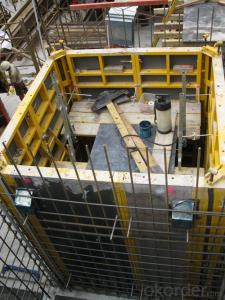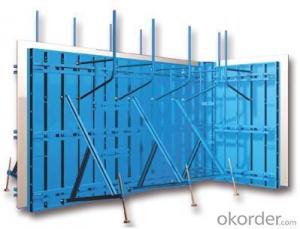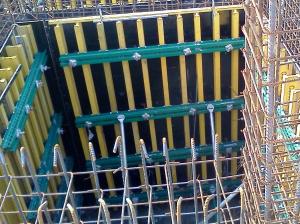Steel Fram Formworks Used in Different Kinds of Construction
- Loading Port:
- Shanghai
- Payment Terms:
- TT OR LC
- Min Order Qty:
- 1 m²
- Supply Capability:
- 100000 m²/month
OKorder Service Pledge
OKorder Financial Service
You Might Also Like
1. Structure of Steel Frame Formwork GK120 Description
There is a prizing part designed in the corner, which can help to position and remove formwork easily.The plywood is screwed on from the back when connecting frame and plywood, so the surface of the finished concrete is perfect.The formwork series are a complete system with a full set of accessories, and can be set up flexibly according to project demand.
2. Main Features of Steel Frame Formwork GK120
-convenient for construction
-easy to control the quality
-easy, rapid and economical.
3. Steel Frame Formwork GK120 Images

4. Steel Frame Formwork GK120Specifications
Steel Frame Formwork GK120 is used for the concrete pouring of square or rectangle column. The system has the same structure and similar connection type with wall formwork.
5.Steel Frame Formwork GK120
1) What can we do for you?
.We can ensure the quality of the Steel Frame Formwork GK120 and avoid extra expenses for customers.
.We can provide you the professional technical team.
.We can provide professional building proposal for your projects.
2) What promises can be done by us?
. If interested in this kind of formwork, please feel free to write us for any QUOTE.
. If need any technical and building assistance, we could provide on-site professional staff for instruction.
. Please DO check goods when courier knocks your door and contact us asap if any issueS.
3) What about of our after-sale services?
. Response will be carried out in 24hours after receiving any complain or request.
. Any formwork cost can be refund after order is confirmed.
. If the products are not based on the requirements, there will be the relevant compensations made for you.
4) What about the package and shipping time?
.Packing: wood package and adhesive tape
.Shipping: by sea
Shipping time: Normally small orders, it just1week business days to arrive your hand; When comes to the customs declaration, it may need 2weeks.
- Q: How does steel frame formwork ensure proper alignment and positioning of concrete structures?
- Steel frame formwork ensures proper alignment and positioning of concrete structures through its strong and rigid construction. The steel frames are designed to be sturdy and stable, providing a reliable support system for the concrete during the pouring and curing process. Firstly, steel frame formwork is assembled in a way that allows for accurate and precise measurements. The frames are typically pre-fabricated and can be easily adjusted and aligned to meet the required dimensions of the structure. This ensures that the concrete will be poured and set in the correct position, preventing any misalignment or deviations from the intended design. Additionally, steel frame formwork provides a level and smooth surface for the concrete to be poured onto. The frames are designed to be flat and even, ensuring that the concrete will be evenly distributed and not settle in any particular area. This helps to maintain the overall integrity and strength of the structure, as well as prevent any potential issues that may arise from uneven pouring. Furthermore, steel frame formwork offers a stable and secure support system for the concrete. The frames are typically reinforced with bracing and tie rods, which help to hold everything in place during the pouring and curing process. This prevents any shifting or movement of the concrete, ensuring that it sets and cures in the desired position. Overall, steel frame formwork plays a crucial role in ensuring the proper alignment and positioning of concrete structures. Its strong and rigid construction, accurate measurements, level surface, and stable support system all contribute to a successful and well-built concrete structure.
- Q: How is a steel frame formwork system assembled and disassembled?
- A steel frame formwork system is assembled by connecting prefabricated steel frames together in the desired configuration. The frames are then secured in place using clamps or pins. Once the concrete is poured and set, the system is disassembled by removing the clamps or pins and dismantling the steel frames, allowing for easy removal of the formwork.
- Q: What are the different types of reinforcements used in conjunction with steel frame formwork?
- Some of the different types of reinforcements used in conjunction with steel frame formwork are steel bars or rebars, wire mesh, and fiber reinforcement.
- Q: Can steel frame formwork be used for both interior and exterior structures?
- Both interior and exterior structures can utilize steel frame formwork. This flexible and sturdy system is commonly employed in construction for a variety of structures, such as buildings, bridges, and tunnels. Its strength and stability make it suitable for applications in both interior and exterior settings. When constructing interior structures, steel frame formwork can be employed to build walls, columns, and slabs. It provides a robust and rigid framework that can withstand the pressure of pouring concrete, ensuring the desired shape and dimensions of the structure. The steel frames can be easily assembled and disassembled, allowing for efficient and rapid construction. Similarly, steel frame formwork is well-suited for exterior structures. It can be used to construct external walls, facades, and other components of the building envelope. The steel frames are resistant to weather conditions and can endure the elements, making them a dependable choice for exterior construction. Additionally, steel frame formwork can be customized to create intricate architectural shapes and designs, enhancing the aesthetic appeal of the structure. Overall, steel frame formwork is a versatile solution that can be employed for both interior and exterior structures. Its strength, durability, and flexibility make it an ideal choice for a wide range of construction projects.
- Q: Can steel frame formwork be used in projects with challenging ground conditions?
- Yes, steel frame formwork can be used in projects with challenging ground conditions. Steel frame formwork is known for its strength, durability, and stability, making it suitable for construction projects where the ground conditions may be unstable or challenging. The steel frame provides a robust structure that can withstand the pressures and forces exerted by the ground, ensuring the safety and stability of the formwork system. Additionally, steel frame formwork can be easily adjusted and modified to adapt to different ground conditions, allowing for efficient and effective construction in challenging environments. Overall, steel frame formwork is a reliable and versatile solution that can be utilized in projects with challenging ground conditions.
- Q: Can steel frame formwork be used for both straight and sloped structures?
- Yes, steel frame formwork can be used for both straight and sloped structures. Steel frame formwork is a versatile system that can be easily adjusted to accommodate different angles and slopes. It provides a stable and sturdy support for concrete pouring, ensuring accurate and precise construction of both straight and sloped structures. The steel frame can be easily assembled and disassembled, allowing for flexibility and adaptability in construction projects with varying requirements. Overall, steel frame formwork is an effective solution for constructing both straight and sloped structures.
- Q: Can steel frame formwork be used for both flat and sloped slab construction?
- Indeed, steel frame formwork is applicable for both flat and sloped slab construction endeavors. This particular formwork option offers a resilient and long-lasting solution for establishing the essential mold or framework required for concrete pouring. It possesses the flexibility to effortlessly adapt to various angles and configurations of slabs, thus rendering it suitable for both flat and sloped surfaces. The steel frame formwork system enables meticulous alignment and furnishes a robust support structure, guaranteeing precise and secure concrete pouring for the slab. Furthermore, this formwork can be utilized multiple times, making it a cost-efficient alternative for both flat and sloped slab construction ventures.
- Q: What are the different types of finishes that can be achieved with steel frame formwork?
- There are several different types of finishes that can be achieved with steel frame formwork. 1. Smooth finish: This is the most common type of finish achieved with steel frame formwork. It results in a sleek and even surface, free from any imperfections. This finish is often used for architectural and decorative purposes, where a high-quality appearance is desired. 2. Textured finish: Steel frame formwork can also be used to create a textured finish on concrete surfaces. This type of finish adds depth and interest to the surface, and can be achieved by using different types of form liners or by applying special coatings or treatments to the steel formwork. 3. Exposed aggregate finish: With steel frame formwork, it is possible to achieve an exposed aggregate finish on concrete surfaces. This type of finish involves removing the top layer of concrete to expose the aggregate particles, resulting in a decorative and textured surface. Steel formwork can be designed to accommodate this process, allowing for precise control over the depth and placement of the exposed aggregate. 4. Stamped finish: Another type of finish that can be achieved with steel frame formwork is a stamped finish. This involves pressing a pattern or design into the surface of the concrete before it sets, creating a textured or imprinted effect. Steel formwork can be customized to accommodate different stamping patterns, allowing for a wide range of design possibilities. 5. Polished finish: Steel frame formwork can also be used to achieve a polished finish on concrete surfaces. This involves grinding and polishing the surface to a smooth and reflective finish. Steel formwork can be designed to support the process of polishing, ensuring a flat and even surface that is suitable for achieving the desired level of shine. Overall, steel frame formwork offers a versatile and flexible solution for achieving a wide range of finishes on concrete surfaces. Whether it is a smooth, textured, exposed aggregate, stamped, or polished finish, steel formwork can be tailored to meet the specific requirements and design preferences of a project.
- Q: How does steel frame formwork handle the placement of reinforcement cages and mats within the concrete structure?
- Steel frame formwork is a versatile and efficient system used in construction projects to create concrete structures. When it comes to handling the placement of reinforcement cages and mats within the concrete structure, steel frame formwork offers several advantages. Firstly, steel frame formwork provides a sturdy and reliable support system for the reinforcement cages and mats. The steel frames are designed to withstand the weight and pressure exerted by the concrete, ensuring that the reinforcement remains in its intended position during the pouring and curing process. Additionally, steel frame formwork allows for precise and accurate placement of reinforcement cages and mats. The frames can be easily adjusted and aligned to ensure that the reinforcement is positioned exactly where it needs to be within the structure. This level of accuracy is crucial to achieve the desired strength and integrity of the concrete. Moreover, steel frame formwork provides easy access for workers to install and secure the reinforcement cages and mats. The open design of the frames allows workers to navigate within the formwork and place the reinforcement according to the project specifications. This accessibility reduces the time and effort required for the reinforcement installation process. Furthermore, steel frame formwork offers flexibility in terms of adapting to different reinforcement configurations. The frames can be customized and adjusted to accommodate various shapes and sizes of reinforcement cages and mats. This adaptability is particularly beneficial when working on complex concrete structures that require intricate reinforcement arrangements. Overall, steel frame formwork is a reliable and efficient system for handling the placement of reinforcement cages and mats within concrete structures. Its sturdy support, precise placement, easy accessibility, and adaptability make it a preferred choice in construction projects.
- Q: How does steel frame formwork compare to aluminum formwork?
- Steel frame formwork is generally regarded as more durable and robust compared to aluminum formwork. It offers higher load-bearing capacity and can withstand greater pressures during concrete placement. While aluminum formwork is lighter and easier to handle, steel frame formwork provides better stability and longevity, making it a preferred choice for large-scale construction projects.
Send your message to us
Steel Fram Formworks Used in Different Kinds of Construction
- Loading Port:
- Shanghai
- Payment Terms:
- TT OR LC
- Min Order Qty:
- 1 m²
- Supply Capability:
- 100000 m²/month
OKorder Service Pledge
OKorder Financial Service
Similar products
Hot products
Hot Searches




























